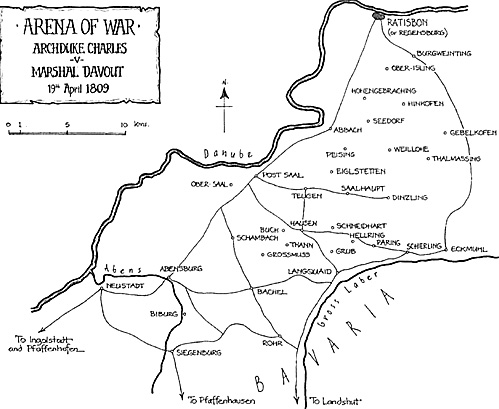The problem with the well-known
accounts of this battle is that they either do not have quite enough detail to
create a wargame, or that they become as confused as the fighting in the
Teugen-Hausen woods. James Arnold's account, which seems to run through
the battle twice, is particularly confused. Petre is also vague. A translation of
the relevant sections of the authoritative Austrian account, "Krieg 1809", was
most enlightening, and after acquiring 1:50,000 mapping of the whole area I
resolved to clarify what occurred and create a wargame. The fight for the ridge
seemed ideal, involving only one Korps of Austrians against a couple of
French divisions. what follows is the result of an attempt to combine the
accounts into something comprehensible.
On the 10 April 1809 an Austrian army of 150,000 men under the Archduke
Charles crossed over the Inn River into Bavaria, achieving strategic surprise.
Meanwhile, north of the Danube, Gdk (General der Kavalerie) Bellegarde with
50,000 troops marched south on Ratisbon iRegensburg). The Tyrol erupted in
revolt against Bavaria and cut French communications with Prince Eugene's
Italian based forces. Napoleon knew they were coming but had been expecting
the attack on or after the I 5th and had lingered in Paris, not wishing to be seen
as provoking the war.
Charles chose to concentrate most of his regular forces on the
Danube, with secondary forces marching on Poland and Italy under the
Archclukes Ferdinand and John respectively. His initial plan was to march
from Bohemia to deal with Marshal Davout and to cut off the French forces in
Northern Germany, but he had decided on a more cautious march up the south
bank of the Danube. Davout, marching south of Ratisbon with 55,000 men,
had detected this on the 27 March and advised Napoleon. The latter was not
expecting a lightning strike from the ponderous Austrians and had left his chief
of staff, Marshal Berthier, in charge of the theatre.
Unfortunately, due to fog, a communications disaster affecting the
visual telegraph system led to a confusion of orders. Berthier was given the
impression that he was to concentrate around Ratisbon rather than further
from the border on the Lech River around Donauworth, over 100 kms west of
Ratisbon. Davout, fully aware of the Austrian concentrations, was evading by
marching south towards the main army but was ordered to countermarch on
Ratisbon and would thus find himself isolated.
Deroi's Bavarian division was at Landshut around 50 kms south of
Ratisbon guarding the Isar River and attempted to slow the Austrians to allow
the French and Allied forces to concentrate. On the 16 April they were forced
back and Charles achieved a classic Napoleonic "Central Position", although
he was unaware of the precise French dispositions. They were actually
scattered on a 120 km front with only a light cordon of Bavarians connecting
Davout to the main forces.
The Austrian march had been slowed to around eight miles a day by
heavy rain, giving Napoleon the opportunity to leave Paris on the 13 April and
to arrive at Donauworth and the front on the 17. This was just in time to sort out
the confusion at headquarters and plan a counteroffensive. This would start on
the 19 against the Austrian rear as Charles headed north to Batisbon.
By 17 April Charles was still unsure how to bring the enemy to battle,
and continued north for a crossing between Ratisbon and Ingolstadt. Here he
could link up with Bellegarcle west of the Danube. The Austrian advance guard
pushed the Bavarians back to the Albans River, while a light brigade under GM
(General-Feldwachtmeister) Vecsay reached Eckmuhl.
On the night of the 17, Napoleon learned that the column coming up
from Landshut was larger than expected and that Bellegarde was nearing his
lines of communication. He deduced that Charles would attack Davout and hold
the Bavarians on his left, hours before the Archduke thought of it himself
towards noon on the 18. He decided that Marshal Massena should take the
offensive towards the Austrian rear by way of Landshut, whilst the Bavarians
held the centre for Davout to rejoin. He would then push Charles against the
Danube and, unable to cross the 'demolished' bridge at Ratisbon, the Austrians
would fold. However, Massena would fail to concentrate quickly and would only
reach Pfaffenhausen, some 50 Vecsay's patrols from Eckmuhl advised their commander that Davout
had remained at Ratisbon on the 18. Charles responded by ordering his main
forces to intercept the Marshal before he could join the Bavarians. In the
meantime, the Archduke Louis and his 5th Korps would hold the three Bavarian
division's attention where they were massing west of the Abens River. The
Austrians had just been given the opportunity to destroy the finest Corps in
French service, under the best Marshal: could they get their blow in quickly
enough, before the rest of the enemy army could respond?
More Battle of Teugen-Hausen 19 April 1809
BACKGROUND: THE CAMPAIGN OF 1809

Introduction and Background
Preparation for Battle
The Battle of Teugen-Hausen
Order of Battle
The Wargame
Back to Age of Napoleon 19 Table of Contents
Back to Age of Napoleon List of Issues
Back to MagWeb Master List of Magazines
© Copyright 1996 by Partizan Press.
This article appears in MagWeb (Magazine Web) on the Internet World Wide Web.
Other military history articles and gaming articles are available at http://www.magweb.com